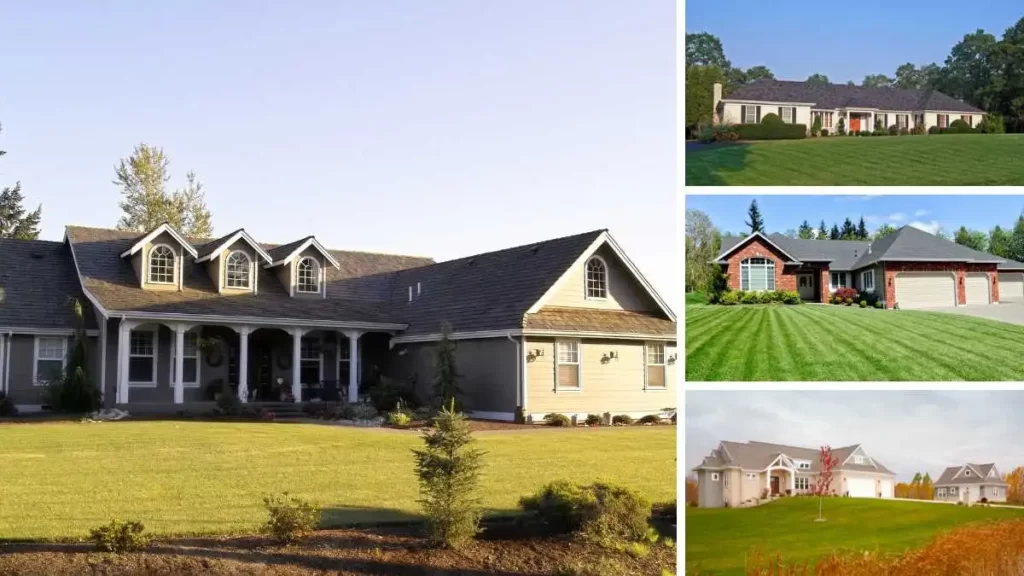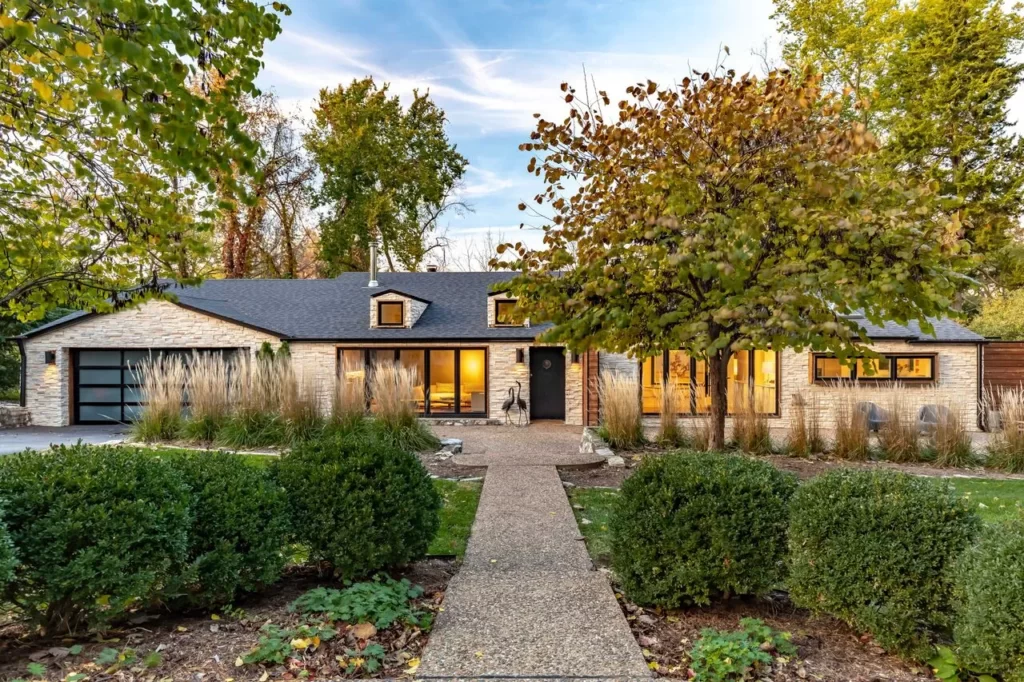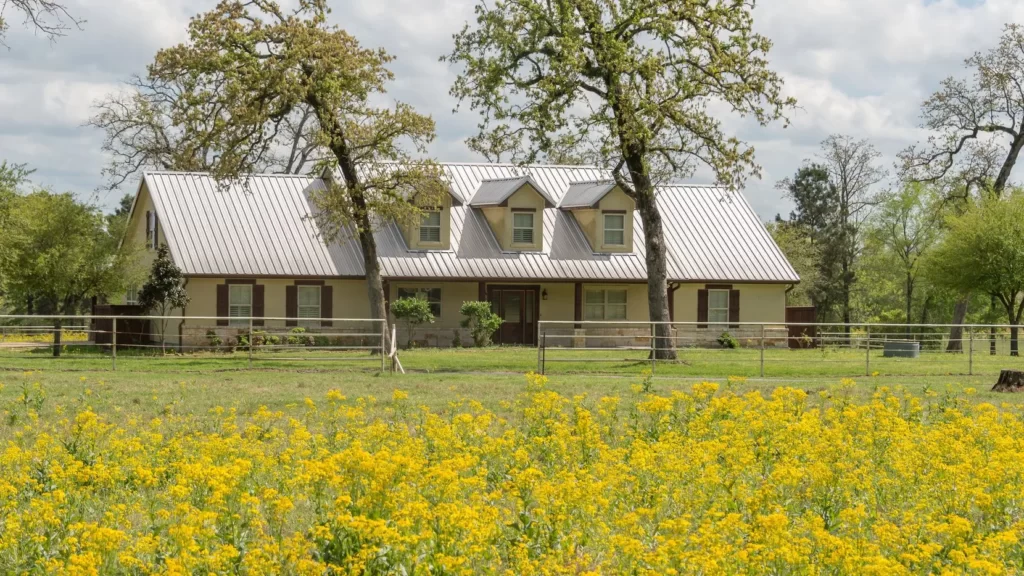If you want to know about the Permeable concrete or Islamic architecture or staircase design, please click the link.
Introduction
The Ranch-style house is a domestic architectural style characterized by its long, low profile, and open floor plan. It typically features a low-pitched roof, a single-story design, and an attached garage.

It emerged as a popular style in the 1940s and 1950s in the United States and was inspired by the Western ranching lifestyle.
A ranch-style house is a one-story, low-to-the-ground home design that is usually associated with the American West. It is also sometimes referred to as a “rambler” or a “California ranch.” The style originated in the 1920s, but became popular in the post-World War II era as a housing solution for returning veterans and their families.
The basic design of a ranch-style house typically includes a low-pitched roof with wide eaves, a simple and open floor plan, and an attached garage. Ranch-style homes can be built with a variety of materials, including brick, stone, stucco, and wood siding.
Historical Background of Ranch-Style Houses
The ranch-style house emerged in the early 20th century as a response to the sprawling ranches of the American West. The style was popularized by architects such as Cliff May and Robert E. Lee, who designed homes that incorporated the Western ranch aesthetic with modern amenities.
However, it wasn’t until the post-World War-II housing boom that ranch-style homes became widely popular. The GI Bill of Rights, which provided home loans and education benefits for veterans, led to a surge in demand for affordable housing.
Ranch-style homes, with their affordable construction costs and easy accessibility, were the perfect solution for many returning soldiers and their families.
In the 1950s and 1960s, ranch-style homes dominated the American housing market. They were seen as symbols of the American dream, offering a comfortable and affordable lifestyle for the middle class.
Although their popularity declined in the 1970s and 1980s, ranch-style homes remain an iconic part of American architecture and continue to be built and renovated today.
Explanation of why it is a popular style
The Ranch-style house is a popular style because it offers a comfortable and relaxed lifestyle. It is designed to be easy to maintain, energy-efficient, and adaptable to different family sizes and needs.
The open floor plan allows for easy movement and socializing, while the large windows and sliding glass doors bring in natural light and create a connection between indoor and outdoor spaces.
Additionally, the Ranch-style house is associated with the American Dream of homeownership and is often seen as a symbol of middle-class prosperity.
1) Characteristics of Ranch-style houses
Ranch-style houses have several distinctive features that make them recognizable:
i) Single-story design
Ranch-style houses are typically designed as a single-story dwelling with a low foundation. This design feature makes them accessible and easy to navigate, especially for elderly or disabled residents.
It also creates a more intimate and cozy living environment, as all rooms are on the same level.
ii) Low-pitched roof
The low-pitched roof is a defining characteristic of Ranch-style houses. It is usually a simple gable or hip roof with a slope of 1:6 to 1:3. The low profile of the roofline gives the house a horizontal emphasis and makes it blend in with the surrounding landscape.
iii) Open floor plans
The open floor plan is another key feature of Ranch-style houses. It creates a spacious and airy living area by removing walls between the kitchen, dining, and living rooms.
The open layout promotes socialization and allows for a natural flow of movement throughout the house.
iv) Attached garages
Ranch-style houses often have an attached garage, which provides easy access to the house and protects the car from the elements. The garage is usually located at the front of the house and blends seamlessly with the rest of the design.
v) Large windows and sliding glass doors
Large windows and sliding glass doors are a common feature of Ranch-style houses. They provide natural light and ventilation, and create a seamless connection between indoor and outdoor spaces.
The windows are often arranged in a horizontal band to accentuate the low profile of the house.
vi) Exterior materials (brick, stucco, wood siding)
The exterior of Ranch-style houses can be clad in a variety of materials, including brick, stucco, and wood siding.
The use of natural materials creates a warm and inviting look, while the horizontal lines of the siding or brickwork emphasize the house’s low profile.
2) Evolution of Ranch-style houses
i) Early Ranch-style houses
The early Ranch-style houses, which emerged in the 1930s and 1940s, were inspired by the Western ranching lifestyle and the Spanish Colonial Revival architecture.
They featured a low-pitched roof, simple rectangular or L-shaped floor plans, and a focus on indoor-outdoor living. The exterior was typically clad in stucco or adobe, and the interior was often decorated with Southwestern or Western motifs.
ii) Mid-century Ranch-style houses
The mid-century Ranch-style houses, which became popular in the 1950s and 1960s, were characterized by their large picture windows, sliding glass doors, and open floor plans. They also featured a variety of new materials, such as glass, steel, and concrete, which allowed for more creative and sculptural designs.
The mid-century Ranch-style houses often incorporated elements of the Modernist and International styles, which emphasized simplicity, functionality, and the use of new materials and technology.
iii) Contemporary Ranch-style houses
The contemporary Ranch-style houses, which emerged in the 21st century, combine the traditional elements of the Ranch-style with new materials, technology, and design features.
They often feature a mix of materials, such as wood, stone, and metal, and incorporate sustainable and energy-efficient features, such as solar panels, geothermal heating, and green roofs.
The contemporary Ranch-style houses also often incorporate the indoor-outdoor living concept, with expansive windows and doors that open up to patios, courtyards, and gardens.
3) Interior Design of Ranch-style houses
i) Open floor plan
The open floor plan of Ranch-style houses creates a spacious and flexible living area that is ideal for modern lifestyles. It allows for easy traffic flow and promotes socialization, as family members and guests can move freely between the kitchen, dining, and living rooms.
The open layout also allows for more natural light to flow throughout the house, which can help to create a bright and cheerful atmosphere.
ii) Functional layout of rooms
The functional layout of rooms in Ranch-style houses is designed to be practical and efficient. The bedrooms are often located in a separate wing of the house, providing privacy and a peaceful retreat from the living areas.
The bathrooms are usually located near the bedrooms, and the kitchen is typically positioned to be the heart of the home, with easy access to the dining and living areas.
iii) Use of natural materials and colors
The use of natural materials and colors is a common feature of Ranch-style house interior design. The materials used in the construction of the house, such as wood, stone, and brick, are often left exposed or used in their natural state.
The color palette is typically muted and earthy, with shades of brown, beige, and green creating a warm and inviting atmosphere.
iv) Mid-century modern furniture and decor
Mid-century modern furniture and decor is a popular choice for Ranch-style house interior design. The clean lines, organic shapes, and minimalist aesthetic of mid-century modern furniture complement the simple and uncluttered design of Ranch-style houses.
Iconic mid-century modern pieces, such as Eames lounge chairs, Noguchi coffee tables, and Saarinen tulip tables, can add a touch of retro style and sophistication to the space.
v) Updated contemporary interior design trends
While mid-century modern design is a popular choice for Ranch-style house interiors, many homeowners are also incorporating updated contemporary design trends into their decor. This can include incorporating bold colors, patterns, and textures into the space, as well as mixing and matching different design styles and eras.
Examples of updated contemporary design trends include industrial chic, Scandinavian minimalism, and eclectic bohemian style.
4) Design Considerations for Ranch-Style Houses
When designing a ranch-style house, there are several important considerations to keep in mind, including:
i) Utilizing Natural Light:
The open floor plan of ranch-style homes allows for ample natural light to enter the home. To maximize this benefit, large windows, skylights, and glass doors should be incorporated into the design.
ii) Incorporating Modern Design Elements:
While ranch-style homes are often associated with traditional design, modern design elements can be incorporated to create a more contemporary look. This can include sleek materials, minimalistic details, and clean lines.
iii) Balancing Aesthetics with Functionality:
It is important to balance the aesthetic appeal of the home with its functional needs. This includes considering the placement of electrical outlets, lighting fixtures, and storage space to ensure the home is both visually appealing and practical.
iv) Adding Outdoor Living Spaces:
Ranch-style homes lend themselves well to outdoor living spaces, such as patios, decks, and porches. These areas can be designed to complement the interior of the home and provide additional space for entertaining or relaxing.
By incorporating these design considerations into the planning process, homeowners can create a ranch-style home that meets their unique style and functional needs.
5) Popular Ranch-Style House Designs
While ranch-style homes share many common features, there are several popular design variations, including:
i) California Ranch:

This design is characterized by a low-pitched roof, long horizontal lines, and a U-shaped layout that often surrounds a central courtyard. The California Ranch is known for its seamless integration with the outdoors, often featuring large sliding glass doors that open onto a patio or deck.
ii) Split-level Ranch:

This design features a multi-level floor plan that allows for a more efficient use of space. The living spaces are typically on one level, while the bedrooms are on another. The split-level ranch is a popular design variation for hillside lots, as it allows for a gradual descent down the slope.
iii) Raised Ranch:

This design features a split-level design with the main living spaces on the upper level and the bedrooms on the lower level. The garage is usually attached to the lower level. The raised ranch design is popular in suburban areas, where the house is built into a slope.
iv) Texas Ranch:

This design is similar to the California Ranch but features a larger footprint and a more traditional ranch aesthetic, with stone or brick exteriors and a gabled roof. The Texas Ranch is known for its grand entrances and expansive porches.
These design variations allow for customization and flexibility in the design of a ranch-style home.
Homeowners can choose a design that best fits their needs and preferences, while still enjoying the benefits of the ranch-style architecture.
6) Benefits of Living in a Ranch-Style House
Ranch-style houses offer several benefits to homeowners, including:
- Easy Accessibility: The single-story design of ranch-style homes makes them easy to navigate and accessible for individuals with mobility issues. They are also ideal for families with young children or pets, as there are no stairs to worry about.
- Spacious Living Areas: The open floor plan of ranch-style homes creates a sense of spaciousness, making them ideal for entertaining guests or for large families.
- Energy Efficiency: Ranch-style homes are typically energy efficient, as they require less energy to heat and cool than multi-story homes. This is due to the smaller roof and foundation, as well as the lack of stairs and vertical spaces.
- Customizable Design Options: Ranch-style homes offer a variety of design options, from the classic California Ranch to the more traditional Texas Ranch. This allows homeowners to customize their home to fit their personal style and needs, while still enjoying the benefits of the ranch-style architecture.
7) Advantages of Ranch-style houses
i) Easy accessibility and convenience
Ranch-style houses are designed with easy accessibility and convenience in mind. Since they are single-story homes, there are no stairs to climb, making it easier for people with mobility issues or disabilities to navigate. Additionally, the open floor plan and wide hallways allow for easy movement throughout the house.
ii) Suitable for aging-in-place
Because of their easy accessibility and convenience, Ranch-style houses are often considered a good choice for aging-in-place. They are designed with safety features, such as slip-resistant flooring and grab bars in the bathroom, and the lack of stairs reduces the risk of falls. Additionally, the functional layout of the rooms makes it easier to get around and perform daily tasks.
iii) Great for families with children and pets
Ranch-style houses are also a popular choice for families with children and pets. The lack of stairs makes it easier for young children and pets to move around the house safely, and the open floor plan allows for easy supervision. Additionally, the ample outdoor space and backyard opportunities provide a safe and enjoyable space for children and pets to play.
iv) Ample outdoor space and backyard opportunities
Ranch-style houses often have ample outdoor space and backyard opportunities. The large windows and sliding glass doors provide a seamless transition between indoor and outdoor living spaces, allowing for easy access to the backyard.
The backyard can be designed to accommodate a variety of activities, such as gardening, outdoor dining, and recreation. This makes Ranch-style houses a great choice for those who enjoy spending time outdoors and entertaining guests.
8) Disadvantages of Ranch-style houses
i) Limited storage space
One disadvantage of Ranch-style houses is that they may have limited storage space. Since they are single-story homes, there may not be an attic or basement for storage, and closets and cabinets may be smaller. This can be a challenge for homeowners who have a lot of belongings and may require additional storage space.
ii) Less privacy in a single-story home
Another disadvantage of Ranch-style houses is that there may be less privacy in a single-story home. Since there are no separate floors, noise and activity from one area of the house can easily carry into other areas. This can be particularly challenging for families with children or for those who work from home and need a quiet space for concentration.
iii) Maintenance and renovation costs
Ranch-style houses may also come with higher maintenance and renovation costs. The large roof and expansive exterior may require more frequent repairs and upkeep, which can be costly.
Additionally, if a homeowner wants to renovate or make significant changes to the floor plan, the lack of structural walls may require additional support beams, which can add to the overall cost of the project.
Overall, while there are certainly advantages to living in a Ranch-style house, it is important for potential homeowners to also consider the potential drawbacks before making a decision.
9) Conclusion
In conclusion, ranch-style houses are a popular and enduring style of architecture that offer several benefits to homeowners.
They are known for their easy accessibility, spacious living areas, energy efficiency, and customizable design options.
Whether you prefer the classic California Ranch or the more traditional Texas Ranch, a ranch-style home may be the perfect fit for your lifestyle and needs.